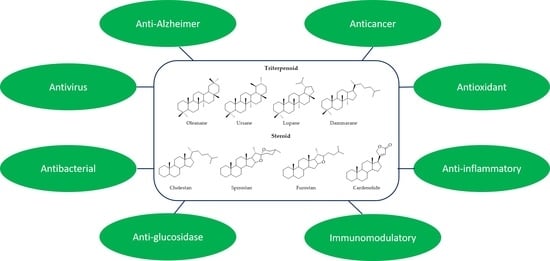Biological and Pharmacological Effects of Synthetic Saponins
Abstract
1. Introduction
2. Triterpenoid Saponin
2.1. Oleanane
2.1.1. Oleanolic Acid
2.1.2. Hederagenin
2.1.3. Quillaic Acid
2.2. Ursane
2.3. Lupane
2.4. Dammarane
3. Steroid Saponin
3.1. Cholestane
3.2. Spirostane
3.3. Furostane
3.4. Cardenolide
4. Discussion
5. Conclusions
Author Contributions
Funding
Acknowledgments
Conflicts of Interest
References
- Abe, I.; Rohmer, M.; Prestwich, G.D. Enzymatic Cyclization of Squalene and Oxidosqualene to Sterols and Triterpenes. Chem. Rev. 1993, 93, 2189–2206. [Google Scholar] [CrossRef]
- Vincken, J.P.; Heng, L.; de Groot, A.; Gruppen, H. Saponins, Classification and Occurrence in the Plant Kingdom. Phytochemistry 2007, 68, 275–297. [Google Scholar] [CrossRef] [PubMed]
- Lorent, J.H.; Quetin-Leclercq, J.; Mingeot-Leclercq, M.P. The Amphiphilic Nature of Saponins and Their Effects on Artificial and Biological Membranes and Potential Consequences for Red Blood and Cancer Cells. Org. Biomol. Chem. 2014, 12, 8803–8822. [Google Scholar] [CrossRef] [PubMed]
- Papadopoulou, K.; Melton, R.E.; Leggett, M.; Daniels, M.J.; Osbourn, A.E. Compromised Disease Resistance in Saponin-Deficient Plants. Proc. Natl. Acad. Sci. USA 1999, 96, 12923–12928. [Google Scholar] [CrossRef] [PubMed]
- Biswas, T.; Dwivedi, U.N. Plant Triterpenoid Saponins: Biosynthesis, in Vitro Production, and Pharmacological Relevance. Protoplasma 2019, 256, 1463–1486. [Google Scholar] [CrossRef] [PubMed]
- Yang, Y.; Laval, S.; Yu, B. Chemical Synthesis of Saponins. Adv. Carbohydr. Chem. Biochem. 2014, 71, 137–226. [Google Scholar] [CrossRef]
- Xiao, G.; Shao, X.; Zhu, D.; Yu, B. Chemical Synthesis of Marine Saponins. Nat. Prod. Rep. 2019, 36, 769–787. [Google Scholar] [CrossRef]
- Lin, T.S.; Tsai, W.T.; Liang, P.H. Rearrangement Reactions in the Fluorination of d-Glucopyranoside at the C-4 Position by Dast. Tetrahedron 2016, 72, 5571–5577. [Google Scholar] [CrossRef]
- Lu, Y.J.; Lai, Y.H.; Lin, Y.Y.; Wang, Y.C.; Liang, P.H. 2-O-N-Benzylcarbamoyl as a Protecting Group to Promote Beta-Selective Glycosylation and Its Applications in the Stereoselective Synthesis of Oligosaccharides. J. Org. Chem. 2018, 83, 3688–3701. [Google Scholar] [CrossRef]
- Hsieh, M.H.; Hung, J.T.; Liw, Y.W.; Lu, Y.J.; Wong, C.H.; Yu, A.L.; Liang, P.H. Synthesis and Evaluation of Acyl-Chain- and Galactose-6″-Modified Analogues of Alpha-Galcer for Nkt Cell Activation. ChemBioChem 2012, 13, 1689–1697. [Google Scholar] [CrossRef]
- Lin, T.S.; Liw, Y.W.; Song, J.S.; Hsieh, T.C.; Yeh, H.W.; Hsu, L.C.; Lin, C.J.; Wu, S.H.; Liang, P.H. Synthesis and Biological Evaluation of Novel C-Aryl d-Glucofuranosides as Sodium-Dependent Glucose Co-Transporter 2 Inhibitors. Bioorg. Med. Chem. 2013, 21, 6282–6291. [Google Scholar] [CrossRef] [PubMed]
- Wang, H.W.; Jiang, P.L.; Lin, S.F.; Lin, H.J.; Ou, K.L.; Deng, W.P.; Lee, L.W.; Huang, Y.Y.; Liang, P.H.; Liu, D.Z. Application of Galactose-Modified Liposomes as a Potent Antigen Presenting Cell Targeted Carrier for Intranasal Immunization. Acta Biomater. 2013, 9, 5681–5688. [Google Scholar] [CrossRef]
- Wang, Y.H.; Yeh, H.W.; Wang, H.W.; Yu, C.C.; Guh, J.H.; Liu, D.Z.; Liang, P.H. Synthesis of a Chlorogenin Glycoside Library Using an Orthogonal Protecting Group Strategy. Carbohydr. Res. 2013, 375, 118–135. [Google Scholar] [CrossRef] [PubMed]
- Zeng, Y.B.; Hsiao, H.M.; Chan, S.H.; Wang, Y.H.; Lin, Y.Y.; Kuo, Y.H.; Guh, J.H.; Liang, P.H. Synthesis and Anti-Cancer Activity of a Glycosyl Library of N-Acetylglucosamine-Bearing Oleanolic Acid. Mol. Divers. 2014, 18, 13–23. [Google Scholar] [CrossRef] [PubMed]
- Chen, K.T.; Huang, D.Y.; Chiu, C.H.; Lin, W.W.; Liang, P.H.; Cheng, W.C. Synthesis of Diverse N-Substituted Muramyl Dipeptide Derivatives and Their Use in a Study of Human Nod2 Stimulation Activity. Chem. Eur. J. 2015, 21, 11984–11988. [Google Scholar] [CrossRef] [PubMed]
- Yeh, H.W.; Lin, T.S.; Wang, H.W.; Cheng, H.W.; Liu, D.Z.; Liang, P.H. S-Linked Sialyloligosaccharides Bearing Liposomes and Micelles as Influenza Virus Inhibitors. Org. Biomol. Chem. 2015, 13, 11518–11528. [Google Scholar] [CrossRef] [PubMed]
- Cheng, H.W.; Wang, H.W.; Wong, T.Y.; Yeh, H.W.; Chen, Y.C.; Liu, D.Z.; Liang, P.H. Synthesis of S-Linked Neuac-Alpha(2-6)-Di-Lacnac Bearing Liposomes for H1n1 Influenza Virus Inhibition Assays. Bioorg. Med. Chem. 2018, 26, 2262–2270. [Google Scholar] [CrossRef] [PubMed]
- Lin, Y.Y.; Chan, S.H.; Juang, Y.P.; Hsiao, H.M.; Guh, J.H.; Liang, P.H. Design, Synthesis and Cytotoxic Activity of N-Modified Oleanolic Saponins Bearing a Glucosamine. Eur. J. Med. Chem. 2018, 143, 1942–1958. [Google Scholar] [CrossRef] [PubMed]
- Wong, T.Y.; Tsai, M.S.; Hsu, L.C.; Lin, S.W.; Liang, P.H. Traversal of the Blood-Brain Barrier by Cleavable l-Lysine Conjugates of Apigenin. J. Agric. Food Chem. 2018, 66, 8124–8131. [Google Scholar] [CrossRef]
- Hng, Y.; Lin, M.H.; Lin, T.S.; Liu, I.C.; Lin, I.C.; Lu, Y.L.; Chang, C.N.; Chiu, P.F.; Tsai, K.C.; Chen, M.J.; et al. Design and Synthesis of 3-Benzylaminocoumarin-7-O-Sulfamate Derivatives as Steroid Sulfatase Inhibitors. Bioorg. Chem. 2020, 96, 103618. [Google Scholar] [CrossRef]
- Juang, Y.P.; Lin, Y.Y.; Chan, S.H.; Chang, C.K.; Shie, J.J.; Hsieh, Y.S.Y.; Guh, J.H.; Liang, P.H. Synthesis, Distribution Analysis and Mechanism Studies of N-Acyl Glucosamine-Bearing Oleanolic Saponins. Bioorg. Chem. 2020, 99, 103835. [Google Scholar] [CrossRef] [PubMed]
- Lin, T.S.; Hsieh, C.H.; Kuo, C.; Juang, Y.P.; Hsieh, Y.S.Y.; Chiang, H.S.; Hung, S.C.; Jiang, C.C.; Liang, P.H. Sulfation Pattern of Chondroitin Sulfate in Human Osteoarthritis Cartilages Reveals a Lower Level of Chondroitin-4-Sulfate. Carbohydr. Polym. 2020, 229, 115496. [Google Scholar] [CrossRef] [PubMed]
- Pollier, J.; Goossens, A. Oleanolic Acid. Phytochemistry 2012, 77, 10–15. [Google Scholar] [CrossRef] [PubMed]
- Lacaille-Dubois, M.A. Updated Insights into the Mechanism of Action and Clinical Profile of the Immunoadjuvant Qs-21: A Review. Phytomedicine 2019, 60, 152905. [Google Scholar] [CrossRef]
- Xu, X.H.; Li, T.; Fong, C.M.; Chen, X.; Chen, X.J.; Wang, Y.T.; Huang, M.Q.; Lu, J.J. Saponins from Chinese Medicines as Anticancer Agents. Molecules 2016, 21, 1326. [Google Scholar] [CrossRef]
- Yu, M.; Si, L.; Wang, Y.; Wu, Y.; Yu, F.; Jiao, P.; Shi, Y.; Wang, H.; Xiao, S.; Fu, G.; et al. Discovery of Pentacyclic Triterpenoids as Potential Entry Inhibitors of Influenza Viruses. J. Med. Chem. 2014, 57, 10058–10071. [Google Scholar] [CrossRef]
- Bottcher, S.; Drusch, S. Saponins—Self-Assembly and Behavior at Aqueous Interfaces. Adv. Colloid Interface Sci. 2017, 243, 105–113. [Google Scholar] [CrossRef]
- Zheng, S.; Wang, Y.; Liu, H.; Chang, W.; Xu, Y.; Lin, F. Prediction of Hemolytic Toxicity for Saponins by Machine-Learning Methods. Chem. Res. Toxicol. 2019, 32, 1014–1026. [Google Scholar] [CrossRef]
- Sui, J.J.; Zhou, W.H.; Liu, D.Y.; Li, M.Q.; Sun, J.S. Highly Efficient Synthesis of Bioactive Oleanane-Type Saponins. Carbohydr. Res. 2017, 452, 43–46. [Google Scholar] [CrossRef]
- Wei, G.; Sun, J.; Luan, W.; Hou, Z.; Wang, S.; Cui, S.; Cheng, M.; Liu, Y. Natural Product Albiziabioside a Conjugated with Pyruvate Dehydrogenase Kinase Inhibitor Dichloroacetate to Induce Apoptosis-Ferroptosis-M2-Tams Polarization for Combined Cancer Therapy. J. Med. Chem. 2019, 62, 8760–8772. [Google Scholar] [CrossRef]
- Wei, G.; Cui, S.; Luan, W.; Wang, S.; Hou, Z.; Liu, Y.; Liu, Y.; Cheng, M. Natural Product-Based Design, Synthesis and Biological Evaluation of Albiziabioside a Derivatives That Selectively Induce Hct116 Cell Death. Eur. J. Med. Chem. 2016, 113, 92–101. [Google Scholar] [CrossRef] [PubMed]
- Fang, Y.; Wang, R.; He, M.; Huang, H.; Wang, Q.; Yang, Z.; Li, Y.; Yang, S.; Jin, Y. Nitric Oxide-Donating Derivatives of Hederacolchiside A1: Synthesis and Biological Evaluation in Vitro and in Vivo as Potential Anticancer Agents. Bioorg. Med. Chem. Lett. 2017, 27, 98–101. [Google Scholar] [CrossRef]
- Fang, Y.; Yang, Z.; Ouyang, H.; Wang, R.; Li, J.; Huang, H.; Jin, Y.; Feng, Y.; Yang, S. Synthesis and Biological Evaluation of Hederacolchiside A1 Derivatives as Anticancer Agents. Bioorg. Med. Chem. Lett. 2016, 26, 4576–4579. [Google Scholar] [CrossRef] [PubMed]
- Wang, L.; Wang, Z.; Su, S.; Xing, Y.; Li, Y.; Li, M.; Liu, J.; Yang, S. Synthesis and Cytotoxicity of Oleanolic Acid Trisaccharide Saponins. Carbohydr. Res. 2017, 442, 9–16. [Google Scholar] [CrossRef]
- Li, H.N.; Wang, H.; Wang, Z.P.; Yan, H.N.; Zhang, M.; Liu, Y.; Cheng, M.S. Synthesis, Antitumor Activity Evaluation and Mechanistic Study of Novel Hederacolchiside A1 Derivatives Bearing an Aryl Triazole Moiety. Bioorg. Med. Chem. 2018, 26, 4025–4033. [Google Scholar] [CrossRef] [PubMed]
- Chen, Z.; Duan, H.; Wang, M.; Han, L.; Liu, Y.; Zhu, Y.; Yang, S. Synthesis, Cytotoxicity and Haemolytic Activity of Pulsatilla Saponin a, D Derivatives. Bioorg. Med. Chem. Lett. 2015, 25, 2550–2554. [Google Scholar] [CrossRef] [PubMed]
- Wei, G.; Wang, S.; Cui, S.; Guo, J.; Liu, Y.; Liu, Y.; Cheng, M. Synthesis and Evaluation of the Anticancer Activity of Albiziabioside a and Its Analogues as Apoptosis Inducers against Human Melanoma Cells. Org. Biomol. Chem. 2014, 12, 5928–5935. [Google Scholar] [CrossRef]
- Li, H.N.; Liu, Y.; Zhang, Z.P.; Wang, Z.P.; Hao, J.Z.; Li, F.R.; Fan, Z.F.; Zou, L.B.; Cheng, M.S. Synthesis, Biological Evaluation and Structure-Activity Relationship Studies of Hederacolchiside E and Its Derivatives as Potential Anti-Alzheimer Agents. Eur. J. Med. Chem. 2018, 143, 376–389. [Google Scholar] [CrossRef]
- Song, G.; Shen, X.; Li, S.; Li, Y.; Si, H.; Fan, J.; Li, J.; Gao, E.; Liu, S. Structure-Activity Relationships of 3-O-Beta-Chacotriosyl Oleanane-Type Triterpenoids as Potential H5n1 Entry Inhibitors. Eur. J. Med. Chem. 2016, 119, 109–121. [Google Scholar] [CrossRef]
- Li, S.; Jia, X.; Shen, X.; Wei, Z.; Jiang, Z.; Liao, Y.; Guo, Y.; Zheng, X.; Zhong, G.; Song, G. Structure-Activity Relationships of 3-O-Beta-Chacotriosyl Oleanic Acid Derivatives as Entry Inhibitors for Highly Pathogenic H5n1 Influenza Virus. Bioorg. Med. Chem. 2017, 25, 4384–4396. [Google Scholar] [CrossRef]
- Liu, Q.C.; Guo, T.T.; Li, F.H.; Li, D. Concise Synthesis of a New Triterpenoid Saponin from the Roots of Gypsophila Oldhamiana and Its Derivatives as Alpha-Glucosidase Inhibitors. New J. Chem. 2016, 40, 9537–9549. [Google Scholar] [CrossRef]
- Shirahata, T.; Nagai, T.; Hirata, N.; Yokoyama, M.; Katsumi, T.; Konishi, N.; Nishino, T.; Makino, K.; Yamada, H.; Kaji, E.; et al. Syntheses and Mucosal Adjuvant Activity of Simplified Oleanolic Acid Saponins Possessing Cinnamoyl Ester. Bioorg. Med. Chem. 2017, 25, 1747–1755. [Google Scholar] [CrossRef] [PubMed]
- Nakamura, R.; Shirahata, T.; Konishi, N.; Takanezawa, Y.; Sone, Y.; Uraguchi, S.; Kobayashi, Y.; Kiyono, M. Oleanolic Acid 3-Glucoside, a Synthetic Oleanane-Type Saponin, Alleviates Methylmercury Toxicity in Vitro and in Vivo. Toxicology 2019, 417, 15–22. [Google Scholar] [CrossRef] [PubMed]
- Abdel-Kader, M.; Hoch, J.; Berger, J.M.; Evans, R.; Miller, J.S.; Wisse, J.H.; Mamber, S.W.; Dalton, J.M.; Kingston, D.G.I. Two Bioactive Saponins from Albizia Subdimidiata from the Suriname Rainforest. J. Nat. Prod. 2001, 64, 536–539. [Google Scholar] [CrossRef] [PubMed]
- Fang, Y.; Hu, D.; Li, H.; Hu, J.; Liu, Y.; Li, Z.; Xu, G.; Chen, L.; Jin, Y.; Yang, S.; et al. Synthesis, Biological Evaluation, and Mode of Action of Pulsatilla Saponin D Derivatives as Promising Anticancer Agents. Front. Pharmacol. 2019, 10, 1208. [Google Scholar] [CrossRef]
- Anderson, O.; Beckett, J.; Briggs, C.C.; Natrass, L.A.; Cranston, C.F.; Wilkinson, E.J.; Owen, J.H.; Williams, R.M.; Loukaidis, A.; Bouillon, M.E.; et al. An Investigation of the Antileishmanial Properties of Semi-Synthetic Saponins. RSC Med. Chem. 2020, 11, 833–842. [Google Scholar] [CrossRef]
- Wang, P.F.; Devalankar, D.A.; Dai, Q.P.; Zhang, P.; Michalek, S.M. Synthesis and Evaluation of Qs-21-Based Immunoadjuvants with a Terminal-Functionalized Side Chain Incorporated in the West Wing Trisaccharide. J. Org. Chem. 2016, 81, 9560–9566. [Google Scholar] [CrossRef]
- Wang, P.; Ding, X.; Kim, H.; Michalek, S.M.; Zhang, P. Structural Effect on Adjuvanticity of Saponins. J. Med. Chem. 2020, 63, 3290–3297. [Google Scholar] [CrossRef]
- Skalamera, D.; Kim, H.; Zhang, P.; Michalek, S.M.; Wang, P. Impact of C28 Oligosaccharide on Adjuvant Activity of Qs-7 Analogues. J. Org. Chem. 2020, in press. [Google Scholar] [CrossRef]
- Liao, Y.; Chen, L.; Li, S.; Cui, Z.N.; Lei, Z.; Li, H.; Liu, S.; Song, G. Structure-Aided Optimization of 3-O-Beta-Chacotriosyl Ursolic Acid as Novel H5n1 Entry Inhibitors with High Selective Index. Bioorg. Med. Chem. 2019, 27, 4048–4058. [Google Scholar] [CrossRef]
- Xu, J.C.; Nie, X.L.; Hong, Y.P.; Jiang, Y.; Wu, G.Q.; Yin, X.L.; Wang, C.R.; Wang, X.Q. Synthesis of Water Soluble Glycosides of Pentacyclic Dihydroxytriterpene Carboxylic Acids as Inhibitors of Alpha-Glucosidase. Carbohydr. Res. 2016, 424, 42–53. [Google Scholar] [CrossRef] [PubMed]
- Tian, Y.; Du, Y.Y.; Shang, H.; Wang, M.; Sun, Z.H.; Wang, B.Q.; Deng, D.; Wang, S.; Xu, X.D.; Sun, G.B.; et al. Calenduloside E Analogues Protecting H9c2 Cardiomyocytes against H2o2-Induced Apoptosis: Design, Synthesis and Biological Evaluation. Front. Pharmacol. 2017, 8, 862. [Google Scholar] [CrossRef]
- Sylla, B.; Lavoie, S.; Legault, J.; Gauthier, C.; Pichette, A. Synthesis, Cytotoxicity and Anti-Inflammatory Activity of Rhamnose-Containing Ursolic and Betulinic Acid Saponins. RSC Adv. 2019, 9, 39743–39757. [Google Scholar] [CrossRef]
- Myszka, H.; Grzywacz, D.; Zdrowowicz, M.; Spisz, P.; Butowska, K.; Rak, J.; Piosik, J.; Jaskiewicz, M.; Kamysz, W.; Liberek, B. Design, Synthesis and Biological Evaluation of Betulin-3-Yl 2-Amino-2-Deoxy-Beta-d-Glycopyranosides. Bioorg. Chem. 2020, 96, 103568. [Google Scholar] [CrossRef] [PubMed]
- Korda, A.; Rarova, L.; Pakulski, Z.; Strnad, M.; Oklestkova, J.; Kuczynska, K.; Cmoch, P.; Gwardiak, K.; Karczewski, R. New Lupane Bidesmosides Exhibiting Strong Cytotoxic Activities in Vitro. Bioorg. Chem. 2020, 100, 103868. [Google Scholar] [CrossRef] [PubMed]
- Strobykina, I.Y.; Garifullin, B.F.; Sharipova, R.R.; Voloshina, A.D.; Strobykina, A.S.; Dobrynin, A.B.; Kataev, V.E. Synthesis and Antimicrobial Activity of Dihydrobetulin N-Acetylglucosaminides. Chem. Nat. Compd. 2017, 53, 1101–1106. [Google Scholar] [CrossRef]
- Strobykina, I.Y.; Garifullin, B.F.; Strobykina, A.S.; Voloshina, A.D.; Sharipova, R.R.; Kataev, V.E. Allobetulin N-Acetylglucosaminide. Synthesis and Antimicrobial Activity. Russ. J. Gene. Chem. 2017, 87, 890–893. [Google Scholar] [CrossRef]
- Yang, J.; Li, X.W.; Sun, T.; Gao, Y.; Chen, Y.X.; Jin, Y.R.; Li, Y. Semisynthesis and Bioactive Evaluation of Oxidized Products from 20(S)-Ginsenoside Rg(3), Rh-2, Protopanaxadiol (Ppd) and Their 20(R)-Epimers as Cytotoxic Agents. Steroids 2016, 106, 26–34. [Google Scholar] [CrossRef]
- Li, M.M.; Chen, Y.P.; Zhang, P.F.; Zhang, L.; Zhou, R.; Xu, Y.; Ding, H.D.; Wang, Q.J.; Wang, Z.C. Semi-Synthesis of Twelve Known 20z/E Pseudo-Ginsenosides and Their Comparative Study of Antioxidative Activity in Free Radical Induced Hemolysis of Rabbit Erythrocytes. Chem. Pharm. Bull. 2018, 66, 535–540. [Google Scholar] [CrossRef]
- Ren, S.; Liu, R.; Wang, Y.; Ding, N.; Li, Y. Synthesis and Biological Evaluation of Ginsenoside Compound K Analogues as a Novel Class of Anti-Asthmatic Agents. Bioorg. Med. Chem. Lett. 2019, 29, 51–55. [Google Scholar] [CrossRef]
- Markus, J.; Mathiyalagan, R.; Kim, Y.J.; Han, Y.; Jimenez-Perez, Z.E.; Veronika, S.; Yang, D.C. Synthesis of Hyaluronic Acid or O-Carboxymethyl Chitosan-Stabilized Zno-Ginsenoside Rh2 Nanocomposites Incorporated with Aqueous Leaf Extract of Dendropanax Morbifera Leveille: In Vitro Studies as Potential Sunscreen Agents. New J. Chem. 2019, 43, 9188–9200. [Google Scholar] [CrossRef]
- Liu, C.; Wang, A.P.; Jin, L.L.; Guo, Y.S.; Li, Y.; Zhao, Z.H.; Lei, P.S. Synthesis, Conformational Analysis and Sar Research of Osw-1 Analogues. Tetrahedron 2016, 72, 4091–4102. [Google Scholar] [CrossRef]
- Sun, L.J.; Wang, R.N.; Wang, X.B.; Dang, Y.J.; Li, W.; Yu, B. Synthesis and Antiproliferative Activities of Osw-1 Analogues Bearing 2-Acylamino-Xylose Residues. Org. Chem. Front. 2019, 6, 2385–2391. [Google Scholar] [CrossRef]
- Kimura, M.; Sasaki, K.; Fukutani, Y.; Yoshida, H.; Ohsawa, I.; Yohda, M.; Sakurai, K. Anticancer Saponin Osw-1 Is a Novel Class of Selective Golgi Stress Inducer. Bioorg. Med. Chem. Lett. 2019, 29, 1732–1736. [Google Scholar] [CrossRef]
- Malabed, R.; Hanashima, S.; Murata, M.; Sakurai, K. Interactions of Osw-1 with Lipid Bilayers in Comparison with Digitonin and Soyasaponin. Langmuir 2020, 36, 3600–3610. [Google Scholar] [CrossRef]
- Chan, S.H.; Liang, P.H.; Guh, J.H. An Integrated Approach to Elucidate Signaling Pathways of Dioscin-Induced Apoptosis, Energy Metabolism and Differentiation in Acute Myeloid Leukemia. Naunyn-Schmiedeberg’s Arch. Pharmacol. 2018, 391, 587–602. [Google Scholar] [CrossRef]
- Li, G.L.; Xu, H.J.; Xu, S.H.; Wang, W.W.; Yu, B.Y.; Zhang, J. Synthesis of Tigogenin Meon-Neoglycosides and Their Antitumor Activity. Fitoterapia 2018, 125, 33–40. [Google Scholar] [CrossRef]
- Grzywacz, D.; Paduszynska, M.; Norkowska, M.; Kamysz, W.; Myszka, H.; Liberek, B. N-Aminoacyl and N-Hydroxyacyl Derivatives of Diosgenyl 2-Amino-2-Deoxy-Beta-d-Glucopyranoside: Synthesis, Antimicrobial and Hemolytic Activities. Bioorg. Med. Chem. 2019, 27, 114923. [Google Scholar] [CrossRef]
- Wang, P.; Hao, J.J.; Zhang, X.L.; Wang, C.; Guan, H.S.; Li, M. Synthesis of Furostanol Glycosides: Discovery of a Potent Alpha-Glucosidase Inhibitor. Org. Biomol. Chem. 2016, 14, 9362–9374. [Google Scholar] [CrossRef]
- Li, X.S.; Ren, Y.C.; Sao, Y.Z.; Liu, J.; Zhang, X.K.; Zhang, Y.W.; Sun, X.L.; Yao, X.S.; Tang, J.S. Synthesis of C-3-Neoglycosides of Digoxigenin and Their Anticancer Activities. Eur. J. Med. Chem. 2018, 145, 252–262. [Google Scholar] [CrossRef]
- Urabe, D.; Nakagawa, Y.; Mukai, K.; Fukushima, K.; Aoki, N.; Itoh, H.; Nagatomo, M.; Inoue, M. Total Synthesis and Biological Evaluation of 19-Hydroxysarmentogenin-3-O-Alpha-l-Rhamnoside, Trewianin, and Their Aglycons. J. Org. Chem. 2018, 83, 13888–13910. [Google Scholar] [CrossRef] [PubMed]
- Khatri, H.R.; Bhattarai, B.; Kaplan, W.; Li, Z.Z.; Long, M.J.C.; Aye, Y.; Nagorny, P. Modular Total Synthesis and Cell-Based Anticancer Activity Evaluation of Ouabagenin and Other Cardiotonic Steroids with Varying Degrees of Oxygenation. J. Am. Chem. Soc. 2019, 141, 4849–4860. [Google Scholar] [CrossRef] [PubMed]
- Tong, X.; Han, L.; Duan, H.; Cui, Y.; Feng, Y.; Zhu, Y.; Chen, Z.; Yang, S. The Derivatives of Pulsatilla Saponin a, a Bioactive Compound from Pulsatilla Chinensis: Their Synthesis, Cytotoxicity, Haemolytic Toxicity and Mechanism of Action. Eur. J. Med. Chem. 2017, 129, 325–336. [Google Scholar] [CrossRef]
- Chen, Z.; Duan, H.; Tong, X.; Hsu, P.; Han, L.; Morris-Natschke, S.L.; Yang, S.; Liu, W.; Lee, K.H. Cytotoxicity, Hemolytic Toxicity, and Mechanism of Action of Pulsatilla Saponin D and Its Synthetic Derivatives. J. Nat. Prod. 2018, 81, 465–474. [Google Scholar] [CrossRef] [PubMed]
- Marciani, D.J. Elucidating the Mechanisms of Action of Saponin-Derived Adjuvants. Trends Pharmacol. Sci. 2018, 39, 573–585. [Google Scholar] [CrossRef] [PubMed]
- Wang, P.F.; Kim, Y.J.; Navarro-Villalobos, M.; Rohde, B.D.; Gin, D.Y. Synthesis of the Potent Immunostimulatory Adjuvant Qs-21a. J. Am. Chem. Soc. 2005, 127, 3256–3257. [Google Scholar] [CrossRef] [PubMed]
- Fernandez-Tejada, A.; Tan, D.S.; Gin, D.Y. Development of Improved Vaccine Adjuvants Based on the Saponin Natural Product Qs-21 through Chemical Synthesis. Acc. Chem. Res. 2016, 49, 1741–1756. [Google Scholar] [CrossRef] [PubMed]
- Wang, P.F.; Dai, Q.P.; Thogaripally, P.; Zhang, P.; Michalek, S.M. Synthesis of Qs-21-Based Immunoadjuvants. J. Org. Chem. 2013, 78, 11525–11534. [Google Scholar] [CrossRef]
- Wang, P.; Skalamera, D.; Sui, X.; Zhang, P.; Michalek, S.M. Synthesis and Evaluation of a Qs-17/18-Based Vaccine Adjuvant. J. Med. Chem. 2019, 62, 1669–1676. [Google Scholar] [CrossRef]
- Wang, P.; Skalamera, D.; Sui, X.; Zhang, P.; Michalek, S.M. Synthesis and Evaluation of Qs-7-Based Vaccine Adjuvants. ACS Infect. Dis. 2019, 5, 974–981. [Google Scholar] [CrossRef]
- Wang, P.; Ding, X.; Kim, H.; Skalamera, D.; Michalek, S.M.; Zhang, P. Vaccine Adjuvants Derivatized from Momordica Saponins I and Ii. J. Med. Chem. 2019, 62, 9976–9982. [Google Scholar] [CrossRef] [PubMed]
- Ghirardello, M.; Ruiz-de-Angulo, A.; Sacristan, N.; Barriales, D.; Jimenez-Barbero, J.; Poveda, A.; Corzana, F.; Anguita, J.; Fernandez-Tejada, A. Exploiting Structure-Activity Relationships of Qs-21 in the Design and Synthesis of Streamlined Saponin Vaccine Adjuvants. Chem. Commun. 2020, 56, 719–722. [Google Scholar] [CrossRef] [PubMed]
- Wozniak, L.; Skapska, S.; Marszalek, K. Ursolic Acid—A Pentacyclic Triterpenoid with a Wide Spectrum of Pharmacological Activities. Molecules 2015, 20, 20614–20641. [Google Scholar] [CrossRef] [PubMed]
- Hussain, H.; Green, I.R.; Ali, I.; Khan, I.A.; Ali, Z.; Al-Sadi, A.M.; Ahmed, I. Ursolic Acid Derivatives for Pharmaceutical Use: A Patent Review (2012–2016). Expert Opin. Ther. Pat. 2017, 27, 1061–1072. [Google Scholar] [CrossRef]
- Mlala, S.; Oyedeji, A.O.; Gondwe, M.; Oyedeji, O.O. Ursolic Acid and Its Derivatives as Bioactive Agents. Molecules 2019, 24, 2751. [Google Scholar] [CrossRef]
- Song, G.P.; Shen, X.T.; Li, S.M.; Li, Y.B.; Liu, Y.P.; Zheng, Y.S.; Lin, R.H.; Fan, J.H.; Ye, H.M.; Liu, S.W. Structure-Activity Relationships of 3-O-Beta-Chacotriosyl Ursolic Acid Derivatives as Novel H5n1 Entry Inhibitors. Eur. J. Med. Chem. 2015, 93, 431–442. [Google Scholar] [CrossRef]
- Li, H.; Chen, L.Z.; Li, S.M.; Liao, Y.X.; Wang, L.; Liu, Z.H.; Liu, S.W.; Song, G.P. Incorporation of Privileged Structures into 3-O-Beta-Chacotriosyl Ursolic Acid Can Enhance Inhibiting the Entry of the H5n1 Virus. Bioorg. Med. Chem. Lett. 2019, 29, 2675–2680. [Google Scholar] [CrossRef]
- Li, S.; Jia, X.; Li, H.; Ye, Y.; Zhang, X.; Gao, Y.; Guo, G.; Liu, S.; Song, G. Structure-Aided Optimization of 3-O-Beta-Chacotriosyl Epiursolic Acid Derivatives as Novel H5n1 Virus Entry Inhibitors. Bioorg. Med. Chem. Lett. 2020, 30, 127518. [Google Scholar] [CrossRef]
- Wang, S.; Tian, Y.; Zhang, J.Y.; Xu, H.B.; Zhou, P.; Wang, M.; Lu, S.B.; Luo, Y.; Wang, M.; Sun, G.B.; et al. Targets Fishing and Identification of Calenduloside E as Hsp90ab1: Design, Synthesis, and Evaluation of Clickable Activity-Based Probe. Front. Pharmacol. 2018, 9, 532. [Google Scholar] [CrossRef]
- Tian, Y.; Wang, S.; Shang, H.; Wang, W.Q.; Wang, B.Q.; Zhang, X.; Xu, X.D.; Sun, G.B.; Sun, X.B. The Clickable Activity-Based Probe of Anti-Apoptotic Calenduloside E. Pharm. Biol. 2019, 57, 133–139. [Google Scholar] [CrossRef]
- Zhao, G.; Yan, W.; Cao, D. Simultaneous Determination of Betulin and Betulinic Acid in White Birch Bark Using Rp-Hplc. J. Pharm. Biomed. Anal. 2007, 43, 959–962. [Google Scholar] [CrossRef] [PubMed]
- Amiri, S.; Dastghaib, S.; Ahmadi, M.; Mehrbod, P.; Khadem, F.; Behrouj, H.; Aghanoori, M.R.; Machaj, F.; Ghamsari, M.; Rosik, J.; et al. Betulin and Its Derivatives as Novel Compounds with Different Pharmacological Effects. Biotechnol. Adv. 2020, 38, 107409. [Google Scholar] [CrossRef] [PubMed]
- Chaturvedi, P.K.; Bhui, K.; Shukla, Y. Lupeol: Connotations for Chemoprevention. Cancer Lett. 2008, 263, 1–13. [Google Scholar] [CrossRef] [PubMed]
- Rastogi, S.; Pandey, M.M.; Rawat, A.K.S. Medicinal Plants of the Genus Betula-Traditional Uses and a Phytochemical-Pharmacological Review. J. Ethnopharmacol. 2015, 159, 62–83. [Google Scholar] [CrossRef] [PubMed]
- Udeani, G.O.; Zhao, G.M.; Geun Shin, Y.; Cooke, B.P.; Graham, J.; Beecher, C.W.; Kinghorn, A.D.; Pezzuto, J.M. Pharmacokinetics and Tissue Distribution of Betulinic Acid in Cd-1 Mice. Biopharm. Drug Dispos. 1999, 20, 379–383. [Google Scholar] [CrossRef]
- Gauthier, C.; Legault, J.; Piochon-Gauthier, M.; Pichette, A. Advances in the Synthesis and Pharmacological Activity of Lupane-Type Triterpenoid Saponins. Phytochem. Rev. 2011, 10, 521–544. [Google Scholar] [CrossRef]
- Mihoub, M.; Pichette, A.; Sylla, B.; Gauthier, C.; Legault, J. Bidesmosidic Betulin Saponin Bearing l-Rhamnopyranoside Moieties Induces Apoptosis and Inhibition of Lung Cancer Cells Growth in Vitro and in Vivo. PLoS ONE 2018, 13, e0193386. [Google Scholar] [CrossRef]
- Cmoch, P.; Korda, A.; Rarova, L.; Oklestkova, J.; Strnad, M.; Luboradzki, R.; Pakulski, Z. Synthesis and Structure-Activity Relationship Study of Cytotoxic Lupane-Type 3 Beta-O-Monodesmosidic Saponins with an Extended C-28 Side Chain. Tetrahedron 2014, 70, 2717–2730. [Google Scholar] [CrossRef]
- Sidoryk, K.; Korda, A.; Rarova, L.; Oklestkova, J.; Strnad, M.; Cmoch, P.; Pakulski, Z.; Gwardiak, K.; Karczewski, R.; Luboradzki, R. Synthesis and Biological Activity of New Homolupanes and Homolupane Saponins. Tetrahedron 2015, 71, 2004–2012. [Google Scholar] [CrossRef]
- Sidoryk, K.; Rarova, L.; Oklestkova, J.; Pakulski, Z.; Strnad, M.; Cmoch, P.; Luboradzki, R. Synthesis of 28a-Homoselenolupanes and 28a-Homoselenolupane Saponins. Org. Biomol. Chem. 2016, 14, 10238–10248. [Google Scholar] [CrossRef]
- Sidoryk, K.; Korda, A.; Rarova, L.; Oklestkova, J.; Pakulski, Z.; Strnad, M.; Cmoch, P.; Gwardiak, K.; Karczewski, R. Synthesis and Cytotoxicity of 28a-Homothiolupanes and 28a-Homothiolupane Saponins. Eur. J. Org. Chem. 2016, 2016, 373–383. [Google Scholar] [CrossRef]
- Piao, X.; Zhang, H.; Kang, J.P.; Yang, D.U.; Li, Y.; Pang, S.; Jin, Y.; Yang, D.C.; Wang, Y. Advances in Saponin Diversity of Panax Ginseng. Molecules 2020, 25, 3452. [Google Scholar] [CrossRef] [PubMed]
- Atopkina, L.N.; Uvarova, N.I.; Elyakov, G.B. Simplified Preparation of the Ginsenoside-Rh-2 Minor Saponin from Ginseng. Carbohydr. Res. 1997, 303, 449–451. [Google Scholar] [CrossRef]
- Liao, J.X.; Sun, J.S.; Niu, Y.M.; Yu, B. Synthesis of Ginsenoside Rh2 and Chikusetsusaponin-Lt8 Via Gold(I)-Catalyzed Glycosylation with a Glycosyl Ortho-Alkynylbenzoate as Donor. Tetrahedron Lett. 2011, 52, 3075–3078. [Google Scholar] [CrossRef]
- Yu, J.; Sun, J.S.; Niu, Y.M.; Li, R.Y.; Liao, J.X.; Zhang, F.Y.; Yu, B. Synthetic Access toward the Diverse Ginsenosides. Chem. Sci. 2013, 4, 3899–3905. [Google Scholar] [CrossRef]
- Huang, L.; Zou, C.; Liu, Y.H.; Li, R.; Duan, W.Y.; Du, R.A.; Yang, W.M. Progress in the Synthesis and Modification on Ginsenosides. Mini-Rev. Org. Chem. 2018, 15, 444–458. [Google Scholar] [CrossRef]
- Qian, G.T.; Wang, Z.C.; Zhao, J.Y.; Li, D.D.; Gao, W.; Wang, B.H.; Sui, D.Y.; Qu, X.R.; Chen, Y.P. Synthesis and Anti-Cancer Cell Activity of Pseudo-Ginsenoside Rh2. Steroids 2014, 92, 1–6. [Google Scholar] [CrossRef]
- Ding, H.D.; Chen, Y.P.; Chen, S.; Li, M.M.; Tan, Z.Y.; Lu, Z.Y.; Zhang, P.F.; Gao, W.; Xu, Y.; Xu, F.F.; et al. Semi-Synthesis and Cellular Effects of Three Different Ginsenosides Derived from Re, Rh-1, and Ppt. Chem. Nat. Compd. 2019, 55, 66–73. [Google Scholar] [CrossRef]
- Kubo, S.; Mimaki, Y.; Terao, M.; Sashida, Y.; Nikaido, T.; Ohmoto, T. Acylated Cholestane Glycosides from the Bulbs of Ornithogalum-Saundersiae. Phytochemistry 1992, 31, 3969–3973. [Google Scholar] [CrossRef]
- Tang, Y.P.; Li, N.G.; Duan, J.A.; Tao, W.W. Structure, Bioactivity, and Chemical Synthesis of Osw-1 and Other Steroidal Glycosides in the Genus Ornithogalum. Chem. Rev. 2013, 113, 5480–5514. [Google Scholar] [CrossRef]
- Yamada, R.; Takeshita, T.; Hiraizumi, M.; Shinohe, D.; Ohta, Y.; Sakurai, K. Fluorescent Analog of Osw-1 and Its Cellular Localization. Bioorg. Med. Chem. Lett. 2014, 24, 1839–1842. [Google Scholar] [CrossRef] [PubMed]
- Sakurai, K.; Takeshita, T.; Hiraizumi, M.; Yamada, R. Synthesis of Osw-1 Derivatives by Site-Selective Acylation and Their Biological Evaluation. Org. Lett. 2014, 16, 6318–6321. [Google Scholar] [CrossRef]
- Yamada, R.; Hiraizumi, M.; Narita, S.; Sakurai, K. Two-Step Synthesis of a Clickable Photoaffinity Probe from an Anticancer Saponin Osw-1 and Its Photochemical Reactivity. Asian J. Org. Chem. 2016, 5, 330–334. [Google Scholar] [CrossRef]
- Sakurai, K.; Hiraizumi, M.; Isogai, N.; Komatsu, R.; Shibata, T.; Ohta, Y. Synthesis of a Fluorescent Photoaffinity Probe of Osw-1 by Site-Selective Acylation of an Inactive Congener and Biological Evaluation. Chem. Commun. 2017, 53, 517–520. [Google Scholar] [CrossRef]
- Hiraizumi, M.; Komatsu, R.; Shibata, T.; Ohta, Y.; Sakurai, K. Dissecting the Structural Basis for the Intracellular Delivery of Osw-1 by Fluorescent Probes. Org. Biomol. Chem. 2017, 15, 3568–3570. [Google Scholar] [CrossRef] [PubMed]
- Malabed, R.; Hanashima, S.; Murata, M.; Sakurai, K. Sterol-Recognition Ability and Membrane-Disrupting Activity of Ornithogalum Saponin Osw-1 and Usual 3-O-Glycosyl Saponins. Biochim. Biophys. Acta Biomembr. 2017, 1859, 2516–2525. [Google Scholar] [CrossRef]
- Parama, D.; Boruah, M.; Kumari, Y.; Rana, V.; Banik, K.; Harsha, C.; Thakur, K.K.; Dutta, U.; Arya, A.; Mao, X.; et al. Diosgenin, a Steroidal Saponin, and Its Analogues: Effective Therapies against Different Chronic Diseases. Life Sci. 2020, 260, 118182. [Google Scholar] [CrossRef] [PubMed]
- Song, G.; Yang, S.; Zhang, W.; Cao, Y.; Wang, P.; Ding, N.; Zhang, Z.; Guo, Y.; Li, Y. Discovery of the First Series of Small Molecule H5n1 Entry Inhibitors. J. Med. Chem. 2009, 52, 7368–7371. [Google Scholar] [CrossRef] [PubMed]
- Wang, B.; Liu, Y.; Wang, Y.S.; Liu, X.; Cheng, M.S. Syntheses and Structure-Activity Relationship Studies of N-Substituted-Beta-d-Glucosaminides as Selective Cytotoxic Agents. Bioorg. Med. Chem. Lett. 2012, 22, 7110–7113. [Google Scholar] [CrossRef] [PubMed]
- Zhang, R.; Huang, B.; Du, D.; Guo, X.; Xin, G.; Xing, Z.; Liang, Y.; Chen, Y.; Chen, Q.; He, Y.; et al. Anti-Thrombosis Effect of Diosgenyl Saponins in Vitro and in Vivo. Steroids 2013, 78, 1064–1070. [Google Scholar] [CrossRef]
- Walczewska, A.; Grzywacz, D.; Bednarczyk, D.; Dawgul, M.; Nowacki, A.; Kamysz, W.; Liberek, B.; Myszka, H. N-Alkyl Derivatives of Diosgenyl 2-Amino-2-Deoxy-Beta-d-Glucopyranoside; Synthesis and Antimicrobial Activity. Beilstein J. Org. Chem. 2015, 11, 869–874. [Google Scholar] [CrossRef] [PubMed]
- Myszka, H.; Sokolowska, P.; Cieslinska, A.; Nowacki, A.; Jaskiewicz, M.; Kamysz, W.; Liberek, B. Diosgenyl 2-Amino-2-Deoxy-Beta-d-Galactopyranoside: Synthesis, Derivatives and Antimicrobial Activity. Beilstein J. Org. Chem. 2017, 13, 2310–2315. [Google Scholar] [CrossRef] [PubMed]
- Gu, G.F.; An, L.; Fang, M.; Guo, Z.W. Efficient One-Pot Synthesis of Tigogenin Saponins and Their Antitumor Activities. Carbohydr. Res. 2014, 383, 21–26. [Google Scholar] [CrossRef]
- Bovicelli, P.; Lupattelli, P.; Fracassi, D.; Mincione, E. Sapogenins and Dimethyldioxirane—A New Entry to Cholestanes Functionalized at the Side-Chain. Tetrahedron Lett. 1994, 35, 935–938. [Google Scholar] [CrossRef]
- Cheng, M.S.; Wang, Q.L.; Tian, Q.; Song, H.Y.; Liu, Y.X.; Li, Q.; Xu, X.; Miao, H.D.; Yao, X.S.; Yang, Z. Total Synthesis of Methyl Protodioscin: A Potent Agent with Antitumor Activity. J. Org. Chem. 2003, 68, 3658–3662. [Google Scholar] [CrossRef]
- Guan, Y.Y.; Zheng, D.; Yan, Z.; Wang, N.; Lei, P.S. Synthesis and Antitumor Activity of 5,6-Dihydro-17-Hydroxy Icogenin Analogs. Eur. J. Med. Chem. 2012, 51, 200–205. [Google Scholar] [CrossRef]
- Yu, B.; Liao, J.C.; Zhang, J.B.; Hui, Y.Z. The First Synthetic Route to Furostan Saponins. Tetrahedron Lett. 2001, 42, 77–79. [Google Scholar] [CrossRef]
- Somberg, J.C.; Mudge, G.H.; Smith, T.W. Therapeutic and Toxic Effects of Charged Digitalis Derivatives. Circulation 1978, 58, 22. [Google Scholar]
- Paula, S.; Tabet, M.R.; Ball, W.J. Interactions between Cardiac Glycosides and Sodium/Potassium-Atpase: Three-Dimensional Structure-Activity Relationship Models for Ligand Binding to the E-2-P-I Form of the Enzyme Versus Activity Inhibition. Biochemistry 2005, 44, 498–510. [Google Scholar] [CrossRef]
- Menger, L.; Vacchelli, E.; Adjemian, S.; Martins, I.; Ma, Y.T.; Shen, S.S.; Yamazaki, T.; Sukkurwala, A.Q.; Michaud, M.; Mignot, G.; et al. Cardiac Glycosides Exert Anticancer Effects by Inducing Immunogenic Cell Death. Sci. Transl. Med. 2012, 4, 143ra199. [Google Scholar] [CrossRef]
- Apetoh, L.; Ghiringhelli, F.; Tesniere, A.; Criollo, A.; Ortiz, C.; Lidereau, R.; Mariette, C.; Chaput, N.; Mira, J.P.; Delaloge, S.; et al. The Interaction between Hmgb1 and Tlr4 Dictates the Outcome of Anticancer Chemotherapy and Radiotherapy. Immunol. Rev. 2007, 220, 47–59. [Google Scholar] [CrossRef] [PubMed]
- Michaud, M.; Martins, I.; Sukkurwala, A.Q.; Adjemian, S.; Ma, Y.T.; Pellegatti, P.; Shen, S.S.; Kepp, O.; Scoazec, M.; Mignot, G.; et al. Autophagy-Dependent Anticancer Immune Responses Induced by Chemotherapeutic Agents in Mice. Science 2011, 334, 1573–1577. [Google Scholar] [CrossRef]
- Senovilla, L.; Vitale, I.; Martins, I.; Tailler, M.; Pailleret, C.; Michaud, M.; Galluzzi, L.; Adjemian, S.; Kepp, O.; Niso-Santano, M.; et al. An Immunosurveillance Mechanism Controls Cancer Cell Ploidy. Science 2012, 337, 1678–1684. [Google Scholar] [CrossRef] [PubMed]
- Menger, L.; Vacchelli, E.; Kepp, O.; Eggermont, A.; Tartour, E.; Zitvogel, L.; Kroemer, G.; Galluzzi, L. Trial Watch Cardiac Glycosides and Cancer Therapy. Oncoimmunology 2013, 2, e23082. [Google Scholar] [CrossRef] [PubMed]
- Wang, D.D.; Li, X.S.; Bao, Y.Z.; Liu, J.; Zhang, X.K.; Yao, X.S.; Sun, X.L.; Tang, J.S. Synthesis of Meon-Neoglycosides of Digoxigenin with 6-Deoxy- and 2,6-Dideoxy-d-Glucose Derivatives and Their Anticancer Activity. Bioorg. Med. Chem. Lett. 2017, 27, 3359–3364. [Google Scholar] [CrossRef] [PubMed]
- Tian, D.M.; Qiao, J.; Bao, Y.Z.; Liu, J.; Zhang, X.K.; Sun, X.L.; Zhang, Y.W.; Yao, X.S.; Tang, J.S. Design and Synthesis of Biotinylated Cardiac Glycosides for Probing Nur77 Protein Inducting Pathway. Bioorg. Med. Chem. Lett. 2019, 29, 707–712. [Google Scholar] [CrossRef] [PubMed]
- Ren, Y.L.; Ribas, H.T.; Heath, K.; Wu, S.J.; Ren, J.H.; Shriwas, P.; Chen, X.Z.; Johnson, M.E.; Cheng, X.L.; Burdette, J.E.; et al. Na+/K+-Atpase-Targeted Cytotoxicity of (+)-Digoxin and Several Semisynthetic Derivatives. J. Nat. Prod. 2020, 83, 638–648. [Google Scholar] [CrossRef]
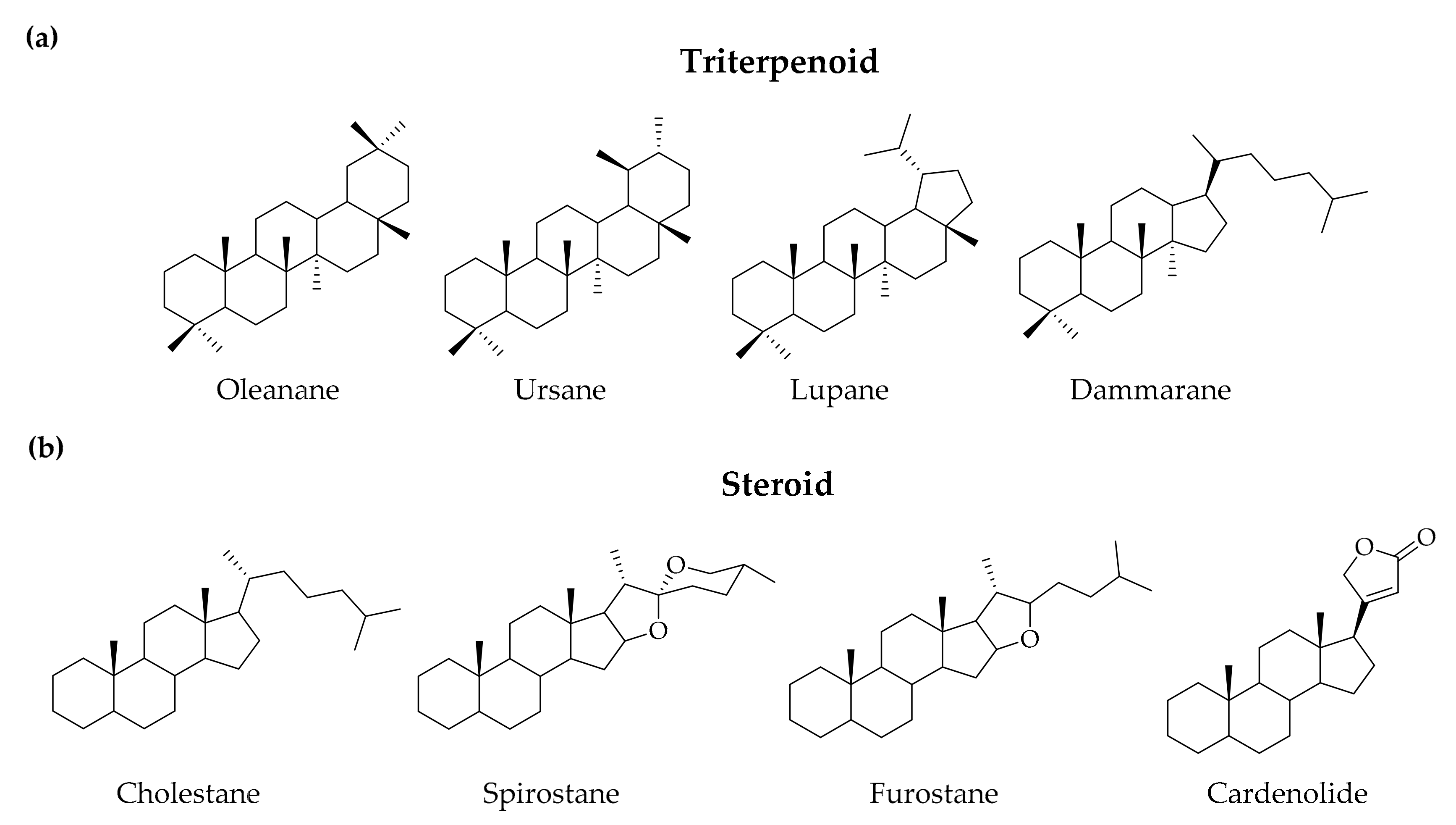
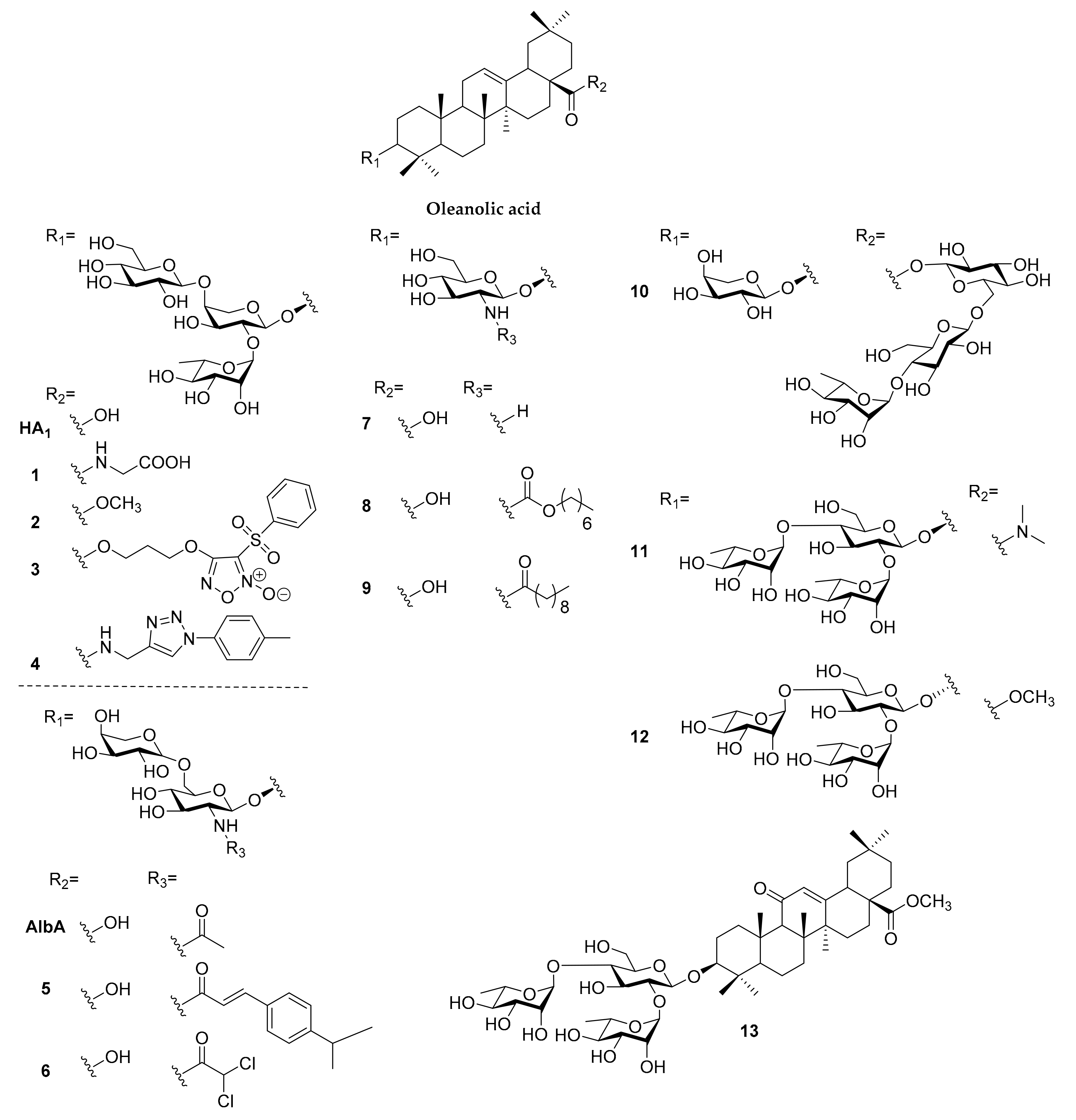

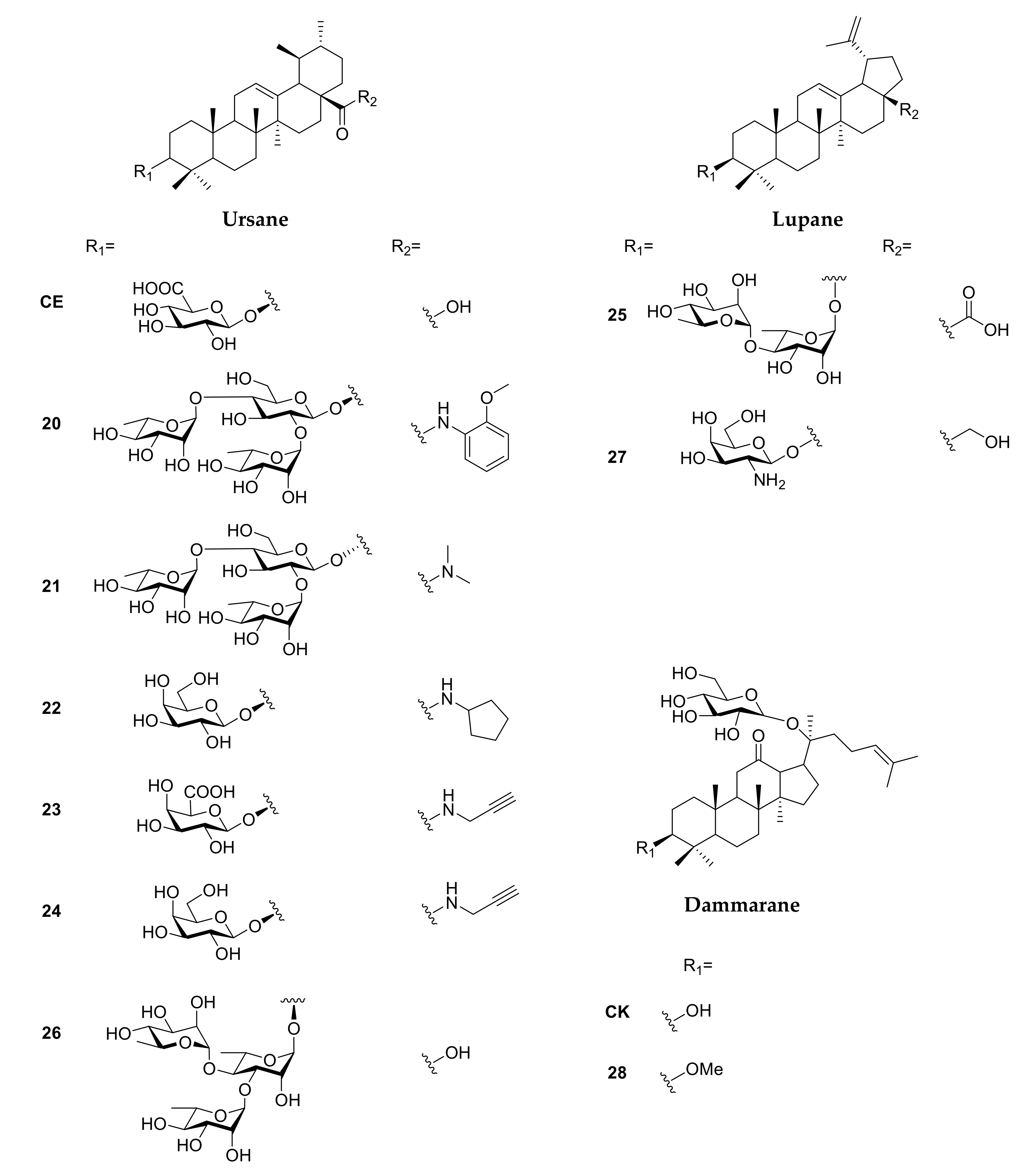
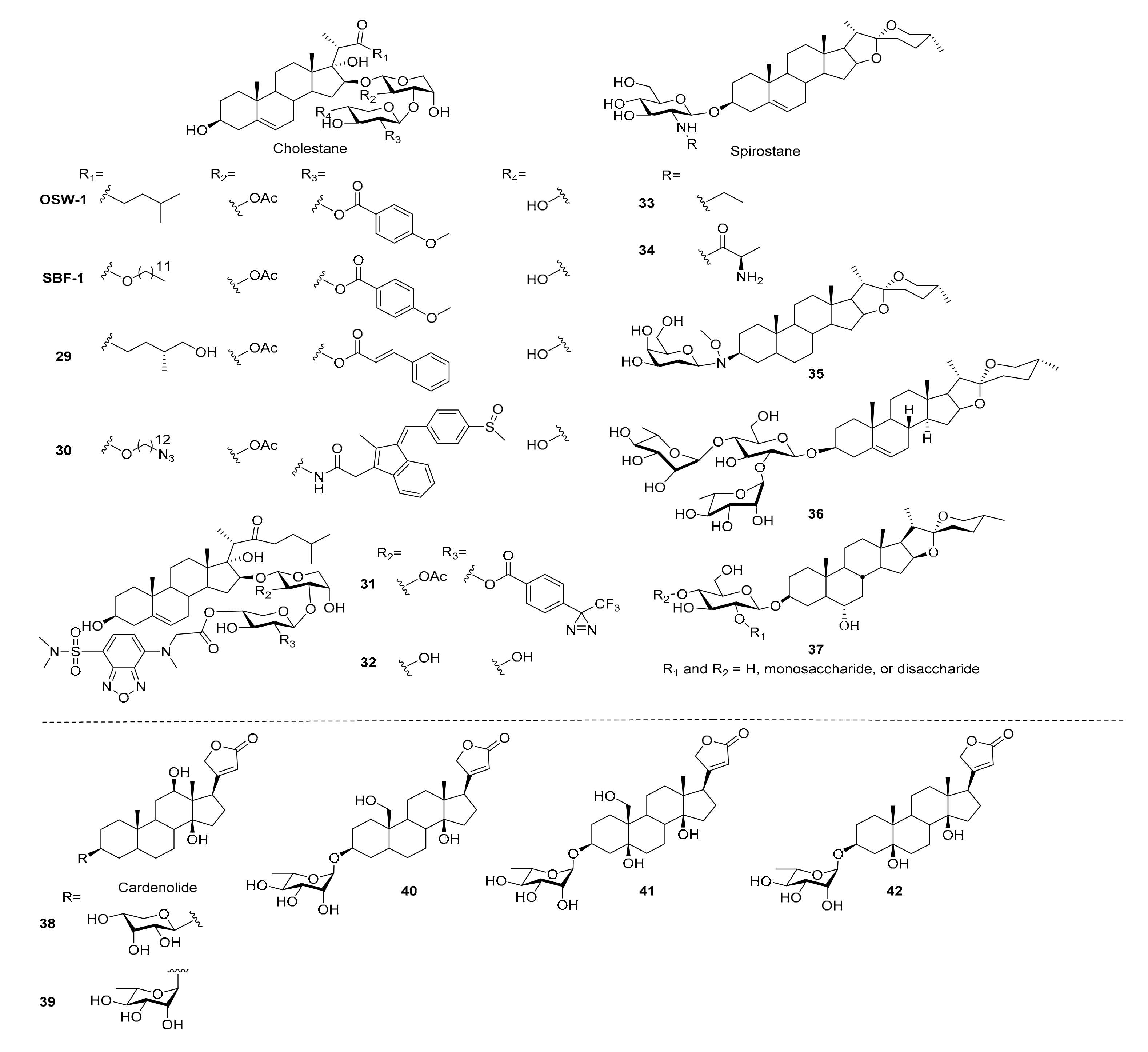
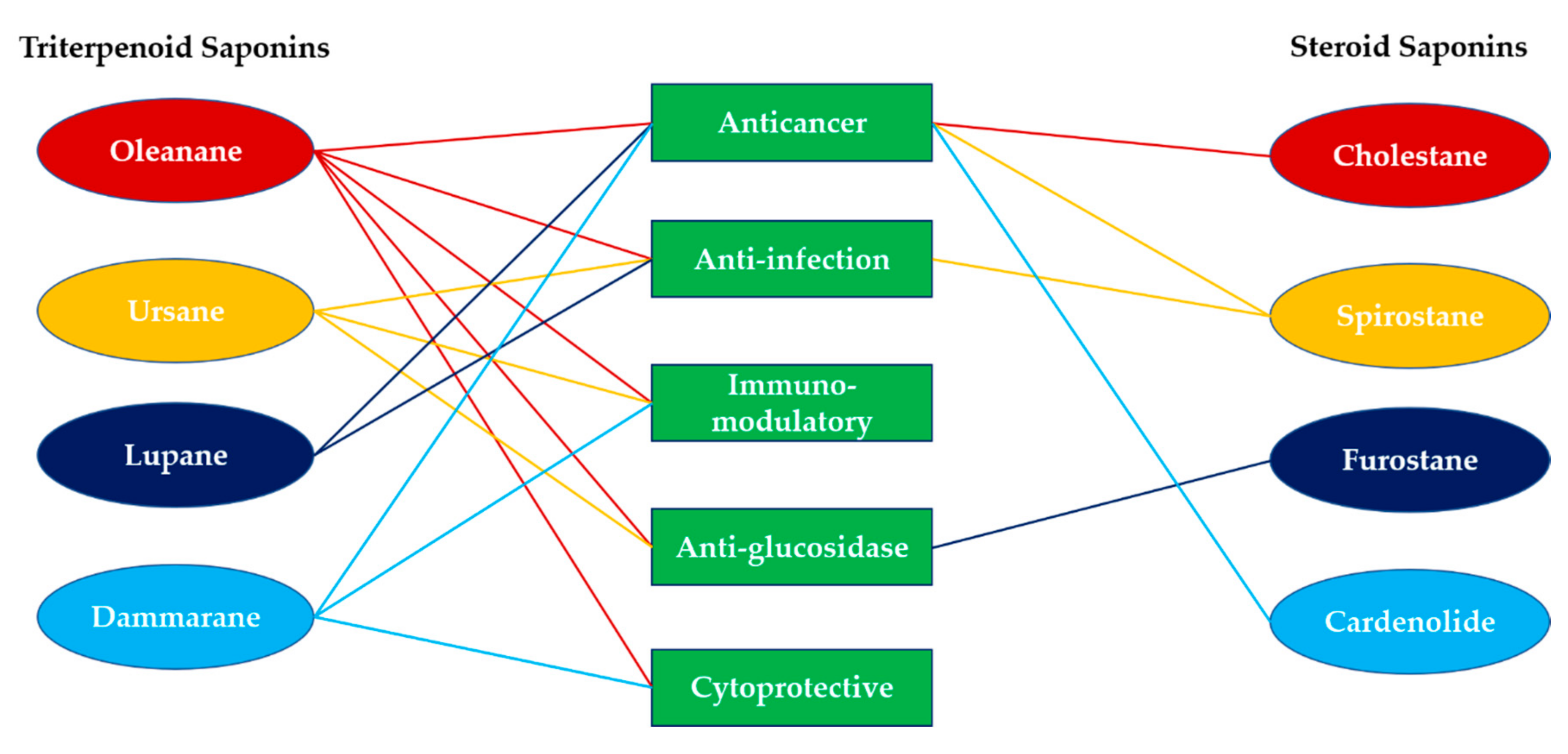
| Sapogenin | Pharmacology | Effect | Reference |
|---|---|---|---|
| Triterpenoid Saponins | |||
| Oleanane (Oleanolic acid) | Anticancer | IC50 = 1.1–4.6 µM against SMMC-7721, NCI-H460, U251, SKOV-3, HCT-116, SGC-7901 in vitro and 46.8% regression in H22 xenograft mouse | [33] |
| IC50 = 1.6–6.5 µM against SMMC-7221, NCI-H460, U251, HCT-116 in vitro and 51.5% regression in H22 xenograft mouse | [32] | ||
| IC50 = 0.5–2.7 µM against PC-3, HT-29, HepG2, A549, HL-60, U937 in vitro | [35] | ||
| IC50 = 7.6 µM against HCT-116 in vitro and >50 µM to human normal cells | [31] | ||
| 50% regression in MCF-7 xenograft mouse | [30] | ||
| IC50 = 0.76 µM against HL-60 | [18] | ||
| IC50 = 5.74 and 2.78 M against HL-60 and HCT-116, respectively | [21] | ||
| Anti-Alzheimer | Protec PC12 from H2O2 and Aβ1–42 induced injury | [38] | |
| Antivirus | Prevent H5N1 infection in MDCK as the selective index > 40 | [39,40] | |
| Glucosidase inhibition | Inhibit -glucosidase with IC50 = 9.2 µM which is 40X stronger than acarbose | [41] | |
| Oleanane (Hederagenin) | Anticancer | IC50 = 1.2–4.7 µM against SMMC-7721, MCF-7, NCI-H460, A549, HCT-116 in vitro and 49.8% regression in H22 xenograft mouse | [45] |
| Antileishmanial | ED50 = 6.0 µM against axenic L. mexicana amastigotes and 29.7 M against host macrophage | [46] | |
| Oleanane (Quillaic acid) | Immunomodulatory | IgG expression higher than GPI-0100 | [47,48] |
| IgG expression higher than QS-21 | [49] | ||
| Ursane | Antivirus | Prevent H5N1 infection in MDCK as the selective index > 950 | [50] |
| Glucosidase inhibition | Inhibit -glucosidase with IC50 = 448 µM which is comparable to acarbose | [51] | |
| Antioxidant | Protect H9c2 cardiomyocytes from H2O2 induced apoptosis in a dose-dependent manner (0.02–0.5 µg/mL) | [52] | |
| Anti-inflammatory | EC50 = 9.8 µM for preventing NO overproduction induced by LPS in macrophages | [53] | |
| Lupane | Anticancer | IC50 = 5.0 µM and >100 against DLD-1 and WS-1, respectively (high selectivity index) | |
| IC50 = 1.7 and 4.2 µM against MCF-7 and HDFa, respectively (low selectivity index) | [54] | ||
| IC50 = 0.9–2.6 µM against CEM, MCF-7, HeLa, G-361 and 1.3 M against BJ normal cells | [55] | ||
| Antibacterial | MIC = 7.8–15.5 µg/mL against Staphylococcus aureus | [56,57] | |
| Dammarane | Anticancer | IC50 =4.6 µM against HeLa cells | [58] |
| Antioxidant | Inhibit the AAPH-induced hemolysis in rabbit erythrocytes | [59] | |
| Antiasthma | Effective in reducing IgE plasma level and airway resistance in OVA-induced asthmatic mouse model | [60] | |
| Skin protection | Conjugation of ginsenoside Rh2 with ZnONcs can increase SPF rating and reduce toxicity in HaCaT cells | [61] | |
| Steroid Saponins | |||
| Cholestane | Anticancer | IC50 = 0.0012–13.0 µM against HCT-116, NCI-H1975, Capan2, SW1990, SK-N-SH, BGC823, HepG2. | [62] |
| IC50 = 0.0054 and 0.16 µM against Jurkat cancer cells and CRL1999 normal cells, respectively | [63] | ||
| Identify the apoptosis induced by OSW-1 might result from Golgi response through CREB3-ARF4 pathway and interaction between OSW-1 and cholesterol | [64,65] | ||
| Spirostane | Anticancer | IC50 = 1–2 µM against leukemia cell CCRF and induced a profound increase in protein expression of CCAAT/enhancer-binding protein α (C/EBPα) | [13,66] |
| IC50 = 2.7 and 4.6 µM against HepG2 and MCF-7, respectiviely | [67] | ||
| Antimicrobial and Antifungal | MIC = 2–8 µg/mL against Candida, Staphylococcus, Enterococcus, Bacillus species | [68] | |
| Furostane | Glucosidase inhibition | Inhibit α-glucosidase with IC50 = 96 µM which is 12X stronger than acarbose | [69] |
| Cardenolide | Anticancer | Inhibit 70% of NIH-H460 cancer cells at 50 nM | [70] |
| IC50 = 0.108–3.27 µM against MCF-7 | [71] | ||
| Inhibit cancer growth in 0.01–0.1 µM range and no toxicity at 3 µM | [72] | ||
Publisher’s Note: MDPI stays neutral with regard to jurisdictional claims in published maps and institutional affiliations. |
© 2020 by the authors. Licensee MDPI, Basel, Switzerland. This article is an open access article distributed under the terms and conditions of the Creative Commons Attribution (CC BY) license (http://creativecommons.org/licenses/by/4.0/).
Share and Cite
Juang, Y.-P.; Liang, P.-H. Biological and Pharmacological Effects of Synthetic Saponins. Molecules 2020, 25, 4974. https://doi.org/10.3390/molecules25214974
Juang Y-P, Liang P-H. Biological and Pharmacological Effects of Synthetic Saponins. Molecules. 2020; 25(21):4974. https://doi.org/10.3390/molecules25214974
Chicago/Turabian StyleJuang, Yu-Pu, and Pi-Hui Liang. 2020. "Biological and Pharmacological Effects of Synthetic Saponins" Molecules 25, no. 21: 4974. https://doi.org/10.3390/molecules25214974
APA StyleJuang, Y.-P., & Liang, P.-H. (2020). Biological and Pharmacological Effects of Synthetic Saponins. Molecules, 25(21), 4974. https://doi.org/10.3390/molecules25214974





